
Proceratosaurus
An early cousin of the mighty T. rex!
Period
Jurassic
Length
Around 5 to 6 feet long.
Height
Approximately 3 feet at the hip.
Weight
Estimated around 50 pounds.
Proceratosaurus was a small carnivorous dinosaur known for its close relation to the mighty Tyrannosaurus rex. Living during the Middle Jurassic period, it possessed a horn-like structure on its snout. This early theropod was originally thought to be part of the ceratosaurs group but later research positioned it more closely to tyrannosaurids. Despite its modest size, it is an important link in understanding the evolution of larger, more famous relatives.
Diet
Proceratosaurus was a carnivore, feeding primarily on small animals and possibly insects. Its sharp teeth and agile build would have made it an effective predator for catching its prey.
Hunting
It employed ambush tactics to surprise its prey, relying on its reasonably swift movements. Close relatives suggest it may have hunted in small groups or pairs to manage larger targets.
Environmental challenges
During the Jurassic, Proceratosaurus faced fluctuating climates and occasional resource scarcity. These changes required adaptability to survive. Competition with other carnivores for food would have been intense, making hunting efficiency critical. The shifting landscapes, including forests and floodplains, offered diverse but sometimes challenging terrains to navigate.
Speed
Moderate speed for an early theropod.
Lifespan
Likely ranged between 10 to 20 years.
First discovery
Found by F. L. Henwood in Gloucestershire, England, in 1910.
Fun Facts
- Proceratosaurus lived around 165 million years ago during the Middle Jurassic Period.
- Despite its name, Proceratosaurus is not closely related to Ceratosaurus but got its name due to an early misinterpretation of its features.
- It was a small theropod dinosaur, estimated to be about 3 meters long, making it much smaller than the giant theropods like T. rex.
- Proceratosaurus had a distinctive crest on its snout, which may have been used for display or species recognition.
- Fossils of Proceratosaurus were first discovered in England in the early 20th century.
- It is considered an early relative of the more famous Tyrannosaurus rex.
- Proceratosaurus is part of a group called coelurosaurs, which includes birds and other feathered dinosaurs.
Growth and Development
Proceratosaurus likely experienced relatively rapid growth during juvenile stages to avoid predation. Its development involved honing hunting techniques, essential for survival. As it matured, its physical adaptations for predation became more pronounced, allowing it to establish a niche. Fossil evidence suggests gradual but noticeable skeletal changes as it aged.
Habitat
Proceratosaurus inhabited regions with dense vegetation, offering cover for ambush hunting. The environment included forested areas and open spaces, promoting diverse living conditions. It likely thrived near water sources, essential for sustenance and attracting prey. Fossil evidence indicates it preferred humid, temperate climates typical of early Jurassic landscapes.
Interaction with other species
Proceratosaurus's ecosystem included various herbivores and fellow carnivores, leading to complex interactions. Competitors would have posed a threat, requiring strategic hunting and territorial behavior. It may have had symbiotic relationships with scavengers who cleaned up meal remains. Social dynamics within their kind possibly included cooperative hunting or shared territories.
Natural lifespan
Proceratosaurus naturally lived approximately 15 years.
Reproduction
Reproduction was likely egg-based, like most theropods. Nests would have been in sheltered areas to protect against predators. Parental care may have been minimal or non-existent post-hatching, typical of early dinosaurs. Fossilized eggs or nesting sites have yet to be conclusively linked to Proceratosaurus.
Social behaviour
It showed signs of social behavior, potentially hunting in packs. Contact with its kind was possibly limited to mating seasons or group hunting efforts. Hierarchies may have existed within any observed groups, determined by size or experience. Solitary hunting or living was also probable for parts of its life.
Fossil locations
Fossils of Proceratosaurus are primarily found in England. Its discovery in Gloucestershire was initially misclassified but later revised. These fossils are crucial for understanding early theropod evolution. The fossil record primarily includes skull and partial skeletal remains.
